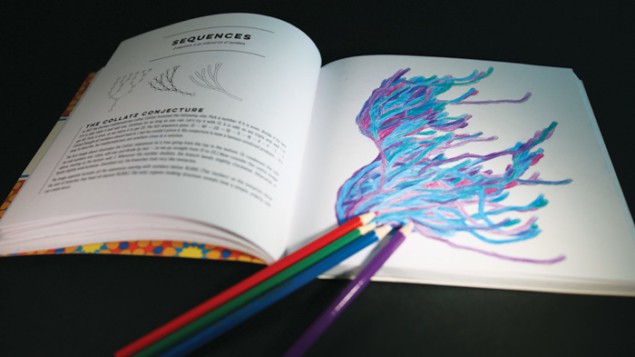Tushna Commissariat reviews Visions of Numberland by Alex Bellos and Edmund Harriss and Phases of Matter by Colm P Kelleher, Rodrigo E Guerra, Andrew D Hollingsworth and Paul M Chaikin

Walk into a bookshop today, or even a gift shop, and you will most likely come across an entire section of colouring books for adults. This rather unexpected global trend has flourished over the past five years or so, with such books topping Amazon’s list of bestsellers in 2015. And if you thought that adult colouring books were a passing fad, as I did when they first started popping up everywhere, then you would be wrong – the market is booming.
The idea behind these books was for adults to have an easy and relaxing activity – whether it’s some form of childhood nostalgia, or a way of switching off and doing something completely different from what most of us do at work. Now, you can find colouring books for grown-ups that feature everything from abstract patterns and detailed nature scenes to books based on films, television shows and even celebrity figures.
It’s no surprise then, that there are quite a few colouring books that are distinctly science-themed. Visions of Numberland: a Colouring Journey Through the Mysteries of Maths by Alex Bellos and Edmund Harriss is one such book that landed on my desk. Its brightly coloured cover is immediately eye-catching and a quick flick through it will reveal a dazzling array of shapes, patterns and illustrations, all waiting to be filled in. The book boasts a total of 60 patterns you can colour in, as well as a “create” section at the end of the book that helps you build your own patterns.
Bellos, who regularly writes about mathematics for the Guardian, is also the author of Alex’s Adventures in Numberland (2010) and Alex Through the Looking-Glass. As for Harriss, he is also a mathematician, teaching at the University of Arkansas, US, but he also specializes in illustrating and creating mathematical art. Between the two of them, Bellos and Harriss have released four colouring books including this latest one, all of which have a mathematical twist.
The illustrations in Visions of Numberland span concepts in algebra, geometry, topology and even computer algorithms. You will come across everything from the familiar Pythagoras theorem to the “hairy ball theorem” (see image). Some of the concepts discussed are well known and understood, while others, such as the Collatz conjecture, are famous “unsolved problems”, making it an interesting mix of things old and new. The square-format book has large illustrations and simple explanations.

But let’s not forget that this is primarily a colouring book, and if the proof of the pudding is in the eating, then the proof of Visions of Numberland is in the filling (in). I do own a few other grown-up colouring books (mostly presents), and while I liked the idea of them initially, I had never actually taken the time to sit down and colour. For the sake of this review, I did have a go at some of the illustrations in the book. The first one I coloured in was the seaweed-like illustration of the aforementioned Collatz conjecture, which describes a mathematical number sequence. I did enjoy pencilling in the tendril-like branches and I was pleased with the final blue and purple hues of my completed picture, which you can see above, but I did find myself getting a bit frustrated with carefully filling in the many small sections.
Despite my impatience, I realized by the time I finished that I was focused solely on the colouring – so maybe it does work as a de-stressing activity? My colleague and Physics World features editor Sarah Tesh, who is more artistically inclined, also coloured in one of the images – she picked the “Hopf fibration”, which is (rather confusingly) a 2D image of a 3D structure built to visualize the surfaces of a 4D sphere – and found the activity rather relaxing. Although I did enjoy the colouring activity and the beautiful pictures that feature in Visions of Numberland, what I ultimately liked best about the book was the actual mathematics discussed. More than half of the concepts and conjectures in the book were new to me and I found them fascinating enough to look them up in an effort to learn more about them. This book is therefore less relaxing colouring book and more mathematical popularization in the best way possible.
Another colouring book for adults, released last month, is Phases of Matter, written and created by condensed-matter physicists Colm P Kelleher, Rodrigo E Guerra, Andrew D Hollingsworth and Paul M Chaikin. According to the authors, the book’s aim is to “explore the beautiful patterns create by microscopic particles in the experiments and computer simulations we conduct in our labs at New York University”. At first glance, I thought this book was a fascinating experiment in popularizing an area of physics that doesn’t often hit the headlines, and I am sure that is what the authors intended. Unfortunately, I do not think they were very successful.

While I enjoyed some of the initial write-up on how the researchers image colloidal particles in the lab, how the particles arrange themselves in a lattice, and how changes in phase occur, I do not think it works as an actual colouring book at all. All of the “images” are full pages covered in minuscule triangles or hexagons with little to no variation. While it is clear to see that each image is tessellated in different ways (to show changes in phase) the patterns look mostly the same. While this does show the reader how a solid and a liquid do not differ that much on a microscopic scale, it makes for an extremely tedious colouring book and I could not bring myself to even try fill in the endless tiny shapes. Indeed, the patterns are so repetitive that you could use this as a distraction akin to doodling while you work, rather than a fun activity. Also, some of the initial microscope images are blurry and out of focus – especially frustrating for pictures that mainly consist of a grid of black dots.
Phases of Matter, while a good idea, was unfortunately badly executed – the book could have really used a professional artist or designer who would have taken the basic ideas and shapes suggested by the researchers and made the patterns more compelling.
- Alex Bellos and Edmund Harriss Visions of Numberland: a Colouring Journey Through the Mysteries of Maths 2017 Bloomsbury Publishing 144pp £9.99pb
- Colm P Kelleher, Rodrigo E Guerra, Andrew D Hollingsworth and Paul M Chaikin Phases of Matter 2017 Green Frog Publishing 62pp £10.99pb
- Enjoy the rest of the October 2017 issue of Physics World in our digital magazine or via the Physics World app for any iOS or Android smartphone or tablet. Membership of the Institute of Physics required



